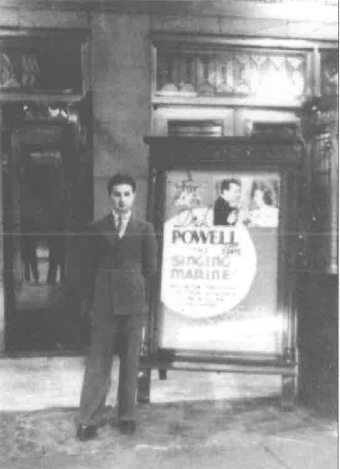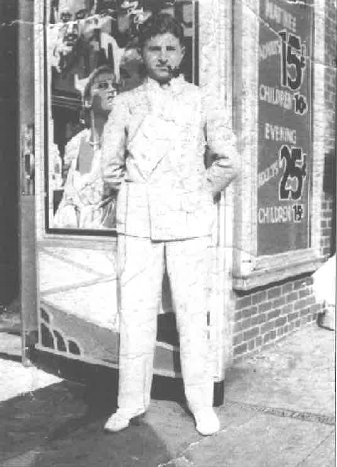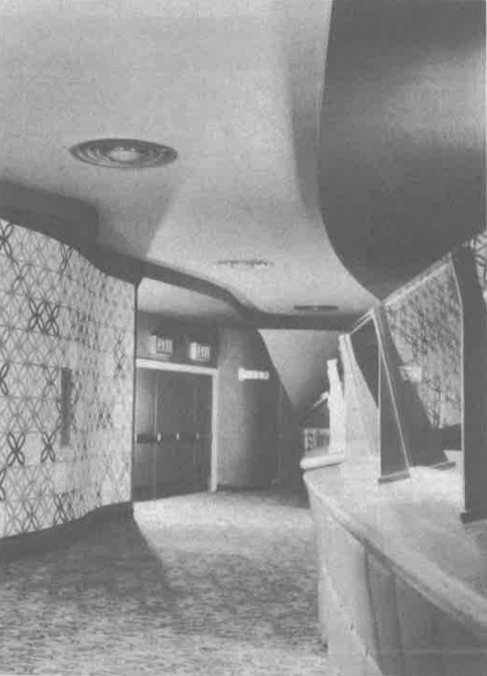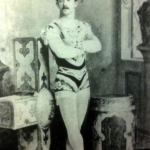MY PHILADELPHIA THEATRE DAYS
MY PHILADELPHIA THEATRE DAYS
(WITH A BRIEF JOURNEY BACK TO NEW JERSEY) BY BARRY S. GOODKIN – Southwest Director, Theatre Historical Society of America
Originally Published for Marquee Magazine 2003 Q3
My father, Lou Goodkin
While still in his teens, started with the Stanley Company of America as an usher at the Stanley Theatre in Philadelphia around 1926.
My mother, Marion Swain, graduated from high school in Wildwood, New Jersey in June 1928 and enrolled in business school in Philadelphia. She was an accomplished pianist and had provided organ accompaniment for silent films at the Blaker Theatre in Wildwood, New Jersey. A friend arranged for her to meet Stuart Barrie, the featured organist at the Stanley Theatre in Philadelphia. Back stage she met my father who by then was chief of service (head usher). That meeting resulted in marriage. Lou Goodkin did not have much of a formal education but he learned much from the films that he watched and the books that he read.
CAPITOL THEATRE; Woodbine, New Jersey In the spring of 1941, Lou accepted a job as manager of the CAPITOL THEATRE in Woodbine, New Jersey. Woodbine was a small farming community and much different from our life in Philadelphia. The country was preparing for the war, and Woodbine had four large factory buildings that had contracts to manufacture military uniforms. My father took a job in one of the clothing factories with better hours and more pay. That was the end of his career in theatre management. My mother, with my younger brother and 1, moved to Wildwood, New Jersey to live with my grandmother. Wildwood is a popular South Jersey seashore resort about eighty-five miles south of Philadelphia.
MY UNCLE, ALLEN GOODKIN
My uncle, Allen Goodkin, was five years younger than my father. In 1933 Lou got Allen a job as an usher at the 1303-seat ALDINE THEATRE, a first-run theatre in Center City Philadelphia. Allen was hired under a federal government work program that paid him $15.00 a week to learn to become an usher. Ushers had to be neat in appearance. They could not point a flashlight above a patron’s shoes. They were not permitted to accept tips. All ushers had to carry a pad and pencil to take notes and they were required to carry a clean handkerchief at all times. The ALDINE did not have air conditioning and, like a number of theatres, would close during the summer months. The ushers would either be laid off or given jobs in other Warner theatres. Allen worked several summers in the 846-seat LEADER THEATRE at 4104 Lancaster Avenue in West Philadelphia. The LEADER was located close to where Allen lived with his parents. Allen became assistant manager of the ALDINE. The ALDINE held the franchise for United Artists films, but according to Allen, the ALDINE was chosen to premier the Walt Disney film Fantasia in 1940. New projection and sound equipment was installed for the film and paid for by RKO, the distributor of the film. Allen held management positions in a number of Warner Philadelphia theatres until the beginning of World War II, when he took a defense related job that paid much better than the theatre jobs. Allen returned to the theatre business after the war, taking a job with Goldman Theatres in Philadelphia.
MY THEATRE CAREER BEGINS HUNT’S CASINO THEATRE; Wildwood, New Jersey
In my junior year of high school, I took a job as a part-time usher at HUNT’S CASINO THEATRE. Movie going was different in those days. We either ran two evening shows or continuous performances. All patrons did not come at the beginning of the performance. As an usher I had to show patrons to available seats and control patrons entering and leaving the aisles. I changed posters and stills in the lobby and outside poster frames. I also changed the attraction signs. I found theatre work more interesting than school. I graduated from high school in June 1950 and continued to work at the CASINO until Labor Day.
Return to Philadelphia
My father maintained friendships with many of the people that he worked with in his theatre managing days. During Christmas week of 1949, William Goldman opened the RANDOLPH THEATRE at 1116 Chestnut Street in Center City Philadelphia. The premiere film was On The Town, a spectacular MGM musical. My father had arranged with Harry Wright, the RANDOLPH THEATRE manager, to allow me to attend one of the performances. It was a beautiful modern theatre . I spoke to Mr. Wright and told him of my work in Hunt’s Theatres. He told me that when I finished high school to contact him and he would give me a job. In September 1950, I went to the RANDOLPH. I was told that Mr. Wright was no longer with the theatre. There were no openings at the RANDOLPH. However, there was an opening at the GOLDMAN THEATRE.
THE GOLDMAN THEATRE
I went to the GOLDMAN and I was interviewed by Ray Meyer, the manager. I was given the job of night ticket taker and barker. On slow evenings I would take tickets, but during opening weeks of new shows, Mr. Meyer would have an usher take tickets and I would stand in front of the box-office where I would maintain the lines of ticket buyers and answer questions regarding show times and seating availability. My barker spiels went something like: “Immediate seating if you go in now” Seating down front or in the balcony only “Another complete show beginning in fifteen”; and “Two cashiers, please step to the next available cash”. I was young, inexperienced and somewhat naive. The one thing I didn’t know at the time was that there were always openings for help at the theatres. I started as ticket taker at $30.00 a week for a six-day week of over forty hours. In a short time, I was promoted to Junior Assistant Manager at $40.00 a week. My duties consisted of being on the floor from about 5 to 10 PM and then taking over for the cashier from 10PM to 12 midnight. The GOLDMAN was opened longer each day than any other first-run theatre in Philadelphia.
A Striking Auditorium
The GOLDMAN THEATRE was the first Center City theatre built after World War II. It was dedicated on August 15, 1946. It had 1300 seats. The theatre was built within the walls of a former restaurant. The architects were David Supowitz and William H. Lee. The exterior had a facing of yellow ceramic panels. There was a forty-five- foot high sign built into the facade of the three-story building with multi-colored neon tubing. Each letter was a different color. There were three retail stores on the street level. William Goldman’s office suite was on the second level and the third level housed the general offices of William Goldman Theatres. The auditorium was very striking with a large contour curtain. Everything was very compact. One set of stairs led to a shallow balcony from the lobby next to the concession stand. Another set of stairs led to the balcony on auditorium right. The lounge was on a lower level and was very modern. The
manager’s office, staff dressing rooms and storage areas were on the lower level behind the lounge. Some of the storage area and the electrician’s crib were in areas of less than six feet in height. One had to be careful not to bump one’s head when accessing those areas.
Follow us










 Previous Post
Previous Post Next Post
Next Post